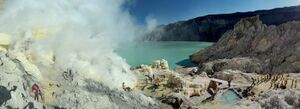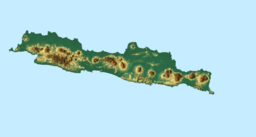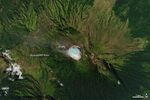Earth:Ijen
| Ijen | |
|---|---|
 Ijen volcano | |
| Highest point | |
| Elevation | 2,769 m (9,085 ft) |
| Listing | Spesial Ribu |
| Coordinates | [ ⚑ ] 8°03′29″S 114°14′31″E / 8.058°S 114.242°E |
| Geography | |
| Location | Border on between Banyuwangi Regency and Bondowoso Regency, Java, Indonesia |
| Geology | |
| Mountain type | Stratovolcano |
| Last eruption | 1999[1] |
thumb|right|Map of Ijen Crater, where sulfur is mined

The Ijen volcano complex is a group of composite volcanoes located on the border between Banyuwangi Regency and Bondowoso Regency of East Java, Indonesia. It is known for its blue fire, acidic crater lake, and labour-intensive sulfur mining.
It is inside an eponymous larger caldera Ijen, which is about 20 kilometres (12 mi) wide. The Gunung Merapi stratovolcano is the highest point of that complex. The name "Gunung Merapi" means 'mountain of fire' in the Indonesian language; Mount Merapi in central Java and Marapi in Sumatra have the same etymology.
Ijen Geopark stretches across It is located across the entire regency which is specifically in the Mount Ijen area, Pulau Merah Beach, and Alas Purwo National Park. It has various geological, biological, and cultural sites. It became part of UNESCO Global Geoparks at the 10th conference held in Marrakesh.
West of Gunung Merapi is the Ijen volcano, which has a one-kilometre-wide (0.62 mi) turquoise-coloured acidic crater lake. The lake is the site of a labour-intensive sulfur mining operation, in which sulfur-laden baskets are carried by hand from the crater floor. The work is paid well considering the cost of living in the area, but is very onerous.[3] Workers earn around US$13 per day and, once out of the crater, still need to carry their loads of sulfur chunks about three kilometers to the nearby Paltuding Valley to get paid.[4]
Many other post-caldera cones and craters are located within the caldera or along its rim. The largest concentration of post-caldera cones runs east–west across the southern side of the caldera. The active crater at Kawah Ijen has a diameter of 722 metres (2,369 ft) and a surface area of 0.41 square kilometres (0.16 sq mi). It is 200 metres (660 ft) deep and has a volume of 36 cubic hectometres (29,000 acre⋅ft).
The lake is recognised as the largest highly acidic crater lake in the world.[1] It is also a source for the river Banyupahit, resulting in highly acidic and metal-enriched river water which has a significant detrimental effect on the downstream river ecosystem.[5] During a scientific expedition in 2001, the pH of the lake was measured at <0.3. [6] On July 14–15, 2008, explorer George Kourounis took a small rubber boat out onto the acid lake to measure its acidity. The pH of the water at the lake's edges was measured to be 0.5 and in the middle of the lake 0.13 due to a high concentration of sulfuric acid.[7]
Blue fire crater
Since National Geographic mentioned the electric-blue flame of Ijen, tourist numbers have increased.[8] The phenomenon has long been known, but midnight hiking tours are a more recent offering. A two-hour hike is required to reach the rim of the crater, followed by a 45-minute hike down to the bank of the crater.
The blue fire is ignited sulfuric gas, which emerges from cracks at temperatures up to 600 °C (1,112 °F). The flames can be up to five meters (16 feet) high; some of the gas condenses to liquid and is still ignited.[9][10]
Ijen is the largest blue flame area in the world. Local people refer to it as Api Biru (Blue Fire).[11] The other location at which blue fire can be seen is in Dallol Mountain, Ethiopia.[12]
Sulfur mining at Ijen
An active vent at the edge of the lake is a source of elemental sulfur and supports a mining operation. Escaping volcanic gases are channeled through a network of ceramic pipes, resulting in condensation of molten sulfur.[citation needed]
The sulfur, which is deep red when molten, pours slowly from the ends of these pipes and pools on the ground, turning bright yellow as it cools. The miners break the cooled material into large pieces and carry it away in baskets. Miners carry loads ranging from 75 to 90 kilograms (165 to 198 lb) up 300 metres (980 ft) to the crater rim, with a gradient of 45 to 60 degrees, and then 3 kilometres (1.9 mi) down the mountain for weighing. Most miners make this journey twice a day.
A nearby sulfur refinery pays the miners by the weight of sulfur transported; as of September 2010, the typical daily earnings were equivalent to approximately $13 US. The miners often receive insufficient protection while working around the volcano[13] and complain of numerous respiratory afflictions. There are 200 miners, who extract 14 tons per day — about 20% of the continuous daily deposit.[14]
Media
Ijen and its sulfur mining was featured in the 1991 IMAX film Ring of Fire, and as a topic on the 5th episode of the BBC television documentary Human Planet.
In the documentary film War Photographer, journalist James Nachtwey visits Ijen and struggles with noxious fumes while trying to photograph workers. Michael Glawogger's film Workingman's Death is about sulfur workers.
Gallery
Kawah Ijen volcano and crater lake, Java, viewed from Landsat 8
See also
- List of volcanoes in Indonesia
- Mazuku
References
- ↑ Jump up to: 1.0 1.1 "Ijen". Smithsonian Institution. https://volcano.si.edu/volcano.cfm?vn=263350.
- ↑ "Photos from inside the volcanic sulphur mines of Indonesia". news.com.au. February 9, 2015. http://www.news.com.au/finance/work/photos-from-inside-the-volcanic-sulphur-mines-of-indonesia/news-story/27daa23f607d4358314fd0a4c5335985.
- ↑ Lane, Megan (9 February 2011). "Sulphur mining in an active volcano". BBC News. https://www.bbc.com/news/world-asia-pacific-12301421.
- ↑ Harsaputra, Indra (19 December 2011). "Kawah Ijen: Between potential and threat". The Jakarta Post. http://www.thejakartapost.com/news/2011/12/19/kawah-ijen-between-potential-threat.html.
- ↑ "University of Amsterdam, Faculty of Earth and Life Sciences, Natural Pollution Caused by the Extremely Acidic Crater Lake Kawah Ijen, East Java, Indonesia". http://www.falw.vu.nl/en/Images/94_tcm24-29686.pdf.
- ↑ Löhr, Ansje; Bogaard, Thom; Heikens, Alex; Hendriks, Martin; Sumarti, Sri; Bergen, Manfred van; Gestel, Kees C.A.M. van; Straalen, Nico van et al. (2005). "Natural Pollution Caused by the Extremely Acid Crater Lake Kawah Ijen, East Java, Indonesia (7 pp)". Environmental Science and Pollution Research International 12 (2): 89–95. doi:10.1065/espr2004.09.118. PMID 15859115. https://pubmed.ncbi.nlm.nih.gov/15859115/#:~:text=The%20Kawah%20Ijen%20crater%20lake,river%20Banyupahit%20(45%20km)..
- ↑ Boating on acid
- ↑ "Wanderlust East Java Tourist Agency". 4 June 2016. http://bromoeastjava.com/blue-flame-ijen-crater-volcano.html.
- ↑ Howard, Brian Clark. "Stunning Electric-Blue Flames Erupt From Volcanoes". http://news.nationalgeographic.com/news/2014/01/140130-kawah-ijen-blue-flame-volcanoes-sulfur-indonesia-pictures/.
- ↑ Schrader, Robert. "The Dark Secret of Indonesia's Blue-Fire Volcano". http://leaveyourdailyhell.com/2014/02/21/how-to-visit-indonesia-blue-fire-volcano-kawah-ijen/.
- ↑ "Gunung Ijen - Selain Rahasia Api Biru, Inilah 4 Fakta Menarik tentang Gunung Berapi Aktif Ini" (in id-ID). https://travel.tribunnews.com/2016/12/27/gunung-ijen-selain-rahasia-api-biru-inilah-4-fakta-menarik-tentang-gunung-berapi-aktif-ini.
- ↑ tourbanyuwangi.com (2019-11-08). "Blue Fire Ijen Crater - Tour Banyuwangi" (in en-US). http://tourbanyuwangi.com/blue-fire-ijen-crater/.
- ↑ Grunewald, Olivier (8 December 2010). "Kawah Ijen by night". Boston Globe. http://www.boston.com/bigpicture/2010/12/kawah_ijen_by_night.html.
- ↑ "Kawah Ijen: Between potential & threat". The Jakarta Post. 19 December 2011. http://www.thejakartapost.com/news/2011/12/19/kawah-ijen-between-potential-threat.html.
External links
| Wikivoyage has a travel guide for Banyuwangi. |
- Ijen Gallery
- Volcanological Survey of Indonesia
- Official website of Indonesian volcanoes at USGS
- The Adventures Behind Filming Ring of Fire
- Large photogallery from Kawah Ijen
- Sulfur mining in Kawah Ijen (The Big Picture photo gallery at Boston.com)
- "Traditional sulfur mining in Kawah Ijen". Yahoo! News. 11 October 2013. https://news.yahoo.com/photos/traditional-sulfur-mining-in-kawah-ijen-1381485234-slideshow/.
- More sulfur mining pictures at Ijen
- Spectacular Neon Blue Lava Pours From Indonesia's Kawah Ijen Volcano At Night (PHOTOS)
 |










